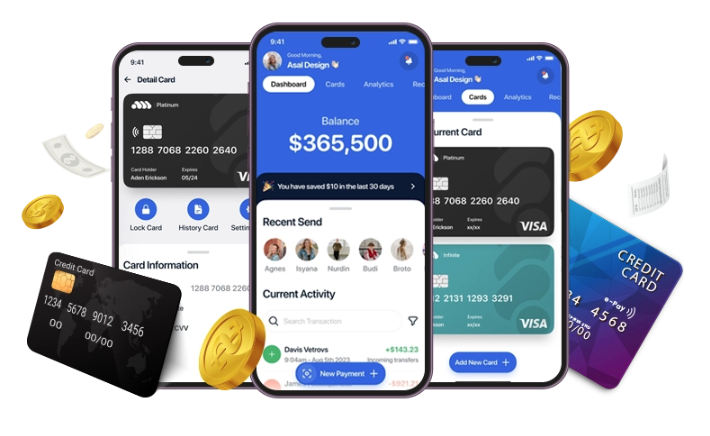In the ever-evolving landscape of finance, technology continues to reshape how we manage our money and interact with financial institutions. One notable transformation is the rise of white label banking app, which is revolutionizing the user experience and redefining the way people engage with their finances. These apps, often developed by third-party providers, are offering a fresh perspective on banking services, accessibility, and convenience. In this article, we’ll explore how white label banking apps are changing the game and why they hold a significant role in shaping the future of finance.
Introduction
The digital age has ushered in a new era of banking, where conventional brick-and-mortar branches are no longer the sole interface for customers. White-label banking apps are at the forefront of this revolution, enabling financial institutions to offer sophisticated and user-friendly platforms without the need for extensive in-house development. This shift is profoundly impacting the way individuals interact with their finances, simplifying processes, and amplifying accessibility.
Understanding White Label Banking Apps
White label banking apps are essentially ready-made software solutions that financial institutions can adopt and customize with their branding and features. These apps are designed to streamline various banking operations, including account management, payments, fund transfers, and even investment tracking. Their flexibility and adaptability make them a valuable asset for banks seeking to modernize their services quickly.
The Advantages of White Label Banking Apps
Enhanced User Experience
White label apps prioritize user-centric design, creating interfaces that are intuitive and visually appealing. This emphasis on user experience enhances engagement, as customers can easily navigate through the app’s functionalities, check their account balances, set up alerts, and manage transactions effortlessly.
Speed and Convenience
Gone are the days of waiting in long queues at the bank. With white label banking apps, users have the power to conduct financial transactions at their fingertips. Whether it’s transferring funds, paying bills, or depositing checks, these apps eliminate the barriers of time and location.
Cost-Effectiveness
Developing a banking app from scratch can be a time-consuming and expensive endeavor. White label solutions offer a cost-effective alternative, enabling financial institutions to leverage pre-built frameworks. This not only reduces development costs but also accelerates the time-to-market for new features and updates.
The Role of Technology
Mobile-First Approach
White label banking apps are designed with a mobile-first mindset, recognizing the dominance of smartphones in today’s society. Users can access their accounts anytime, anywhere, providing a seamless banking experience.
Seamless Integration
Integration with existing banking systems is a crucial aspect of white label apps. These apps are built to seamlessly connect with a bank’s core infrastructure, ensuring a smooth transition for customers and minimizing disruptions.
Personalization through AI
Artificial Intelligence plays a pivotal role in these apps by enabling personalized recommendations and insights based on user behavior. This level of personalization enhances user engagement and fosters a deeper connection between customers and their financial activities.
Fostering Financial Inclusion
White label banking apps contribute to financial inclusion by offering accessible platforms for individuals who may have limited access to traditional banking services. These apps can bridge the gap and provide essential financial tools to underserved populations.
Collaboration between Fintechs and Traditional Institutions
The rise of white label banking apps has fostered collaboration between traditional financial institutions and fintech companies. Fintechs bring innovation and agility, while banks provide regulatory expertise and customer trust. This partnership has the potential to reshape the industry.
Security and Privacy Measures
With digital financial transactions on the rise, concerns about security and privacy are natural. White label banking apps prioritize robust security measures, including encryption, multi-factor authentication, and biometric verification, to safeguard user information and transactions.
Also Read: How Much Does It Cost To Develop An App Like Taskrabbit?
Challenges and Roadblocks
- Regulatory Compliance
Navigating the regulatory landscape while offering innovative financial services can be complex. White label banking apps must adhere to stringent compliance standards to ensure both customer protection and legal adherence.
- Building Trust
Building trust in digital banking solutions is essential. Institutions must communicate their commitment to security and reliability to alleviate concerns that users might have regarding virtual financial management.
- Customization vs. Standardization
Balancing customization options with standardized features is a challenge. Banks must tailor the app to their brand while still providing a consistent user experience across different devices and platforms.
Future Outlook: Transforming the Financial Landscape
The trajectory of white label banking apps points towards a financial landscape where banking is seamless, accessible, and inclusive. As these apps continue to evolve, we can anticipate even more advanced features driven by technology, catering to diverse financial needs.
Conclusion
White label banking apps are reshaping the financial sector by redefining how people manage their money. With a focus on user experience, convenience, and technology-driven innovations, these apps are creating a new standard for banking accessibility and engagement. The partnership between traditional institutions and fintech companies further propels this transformation, offering a glimpse into a future where financial services are at our fingertips.
FAQs
- What exactly is a white label banking app?
A white label banking app is a pre-built software solution that financial institutions can customize with their branding to offer modern banking services.
- How do white label banking apps improve the user experience?
White label banking apps prioritize intuitive design, accessibility, and convenience, enhancing user engagement and satisfaction.
- Are white label banking apps safe to use?
Yes, white label banking apps incorporate robust security measures such as encryption and multi-factor authentication to ensure user data is protected.
- Can traditional banks benefit from these apps?
Absolutely, white label banking apps enable traditional banks to modernize their services quickly and offer a competitive digital banking experience.
- Will white label banking apps replace physical branches?
While physical branches may evolve, white label banking apps are more about complementing traditional services and expanding accessibility.







